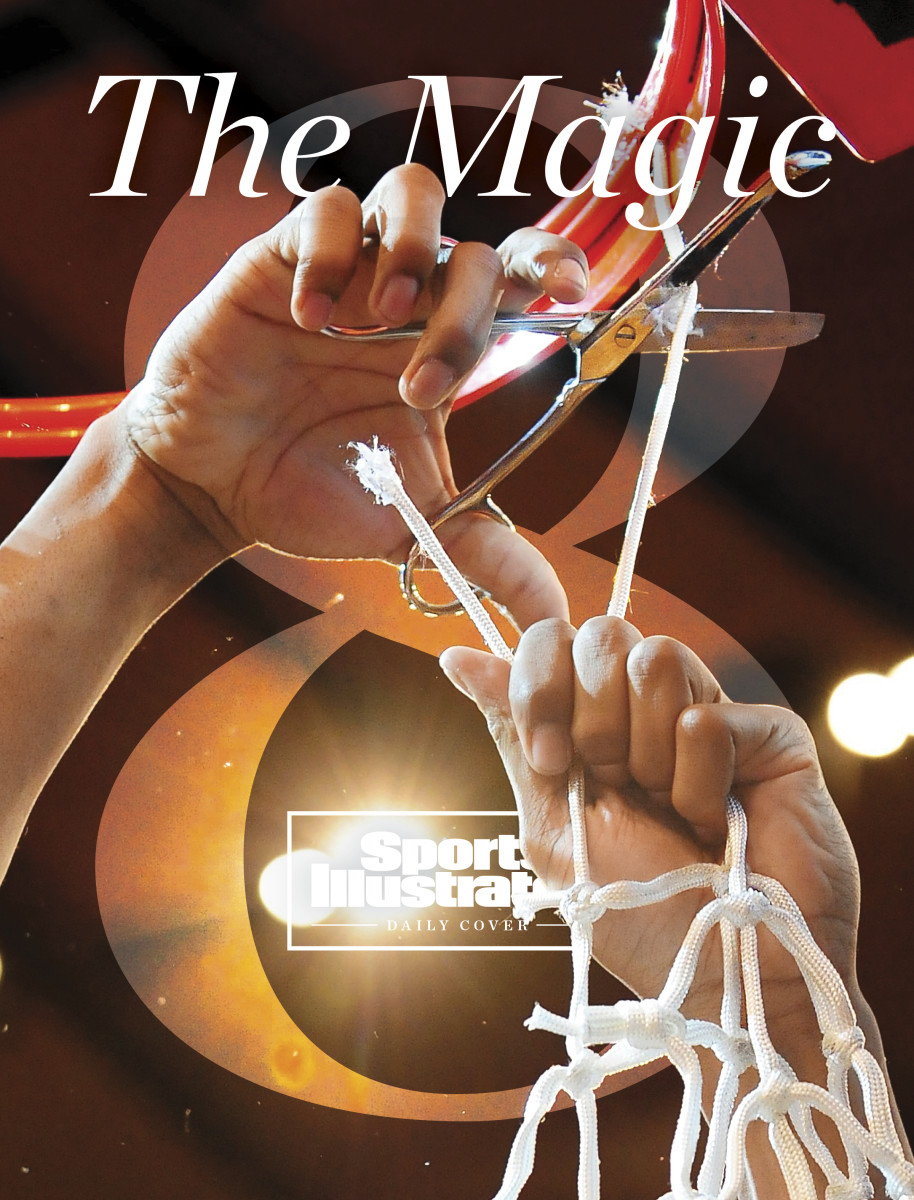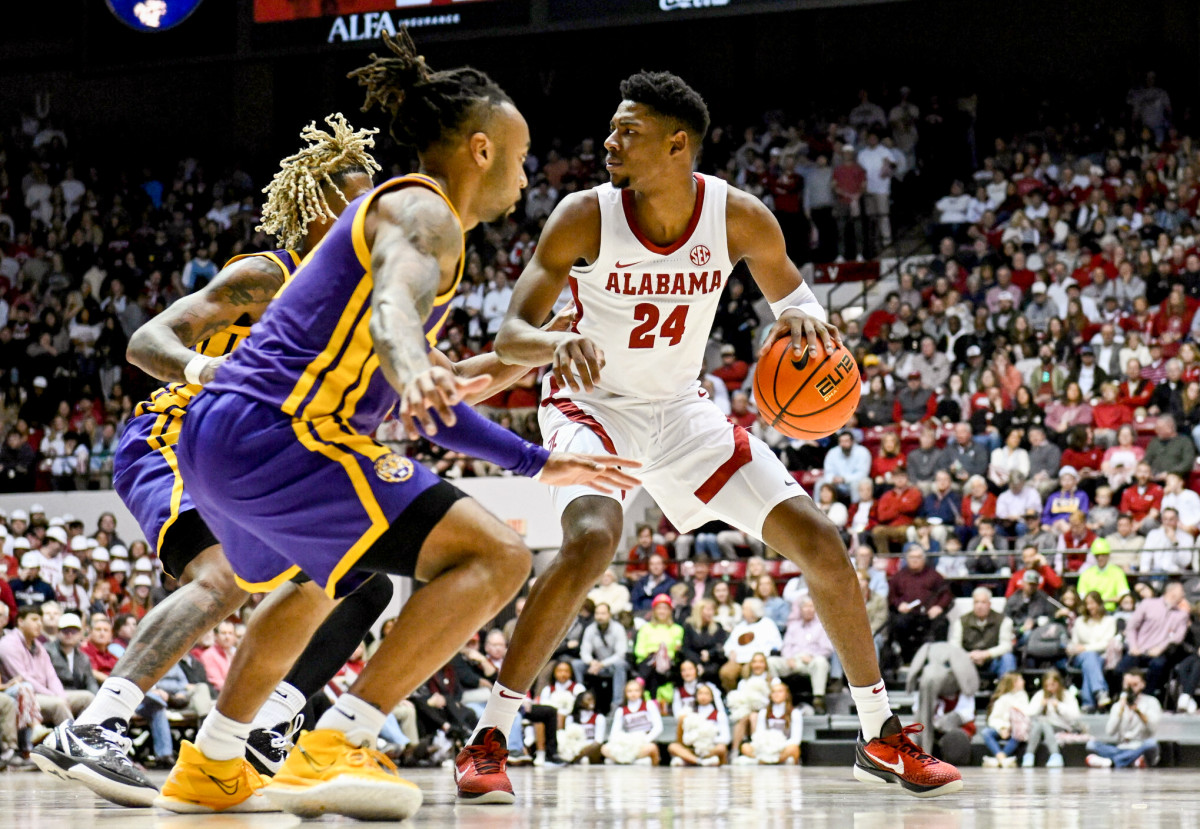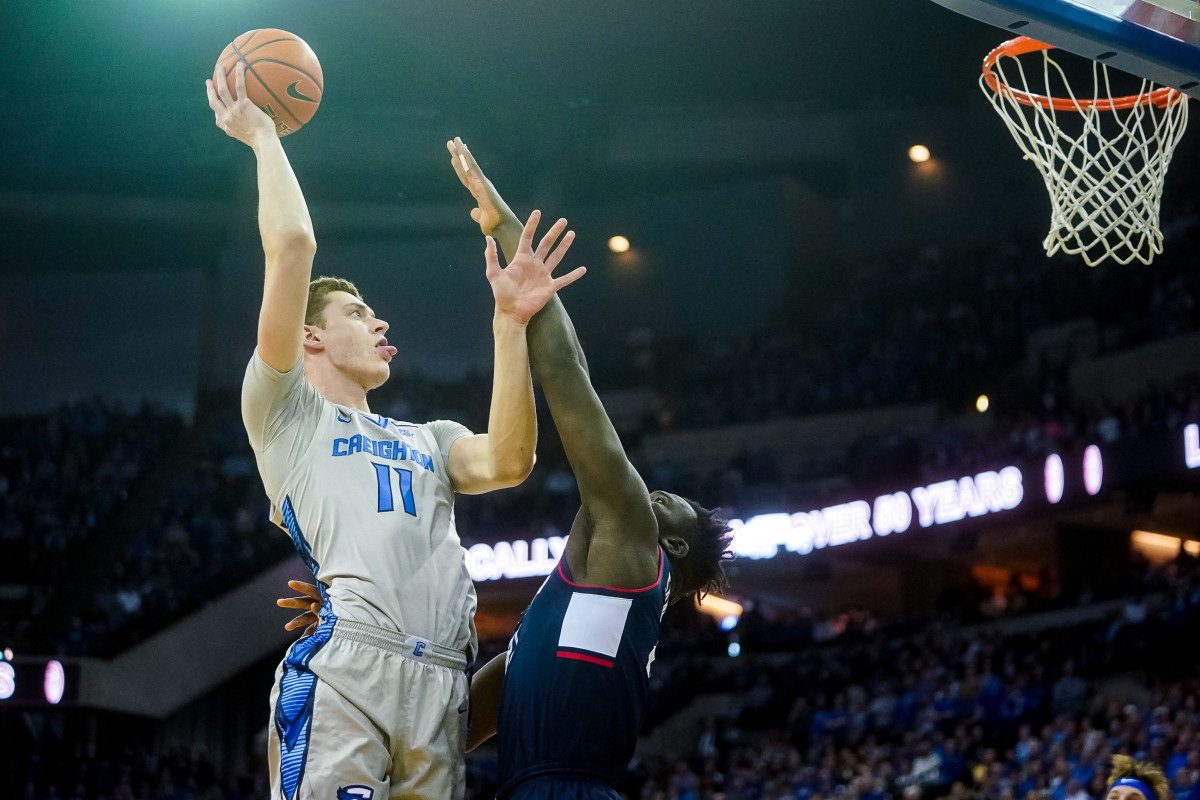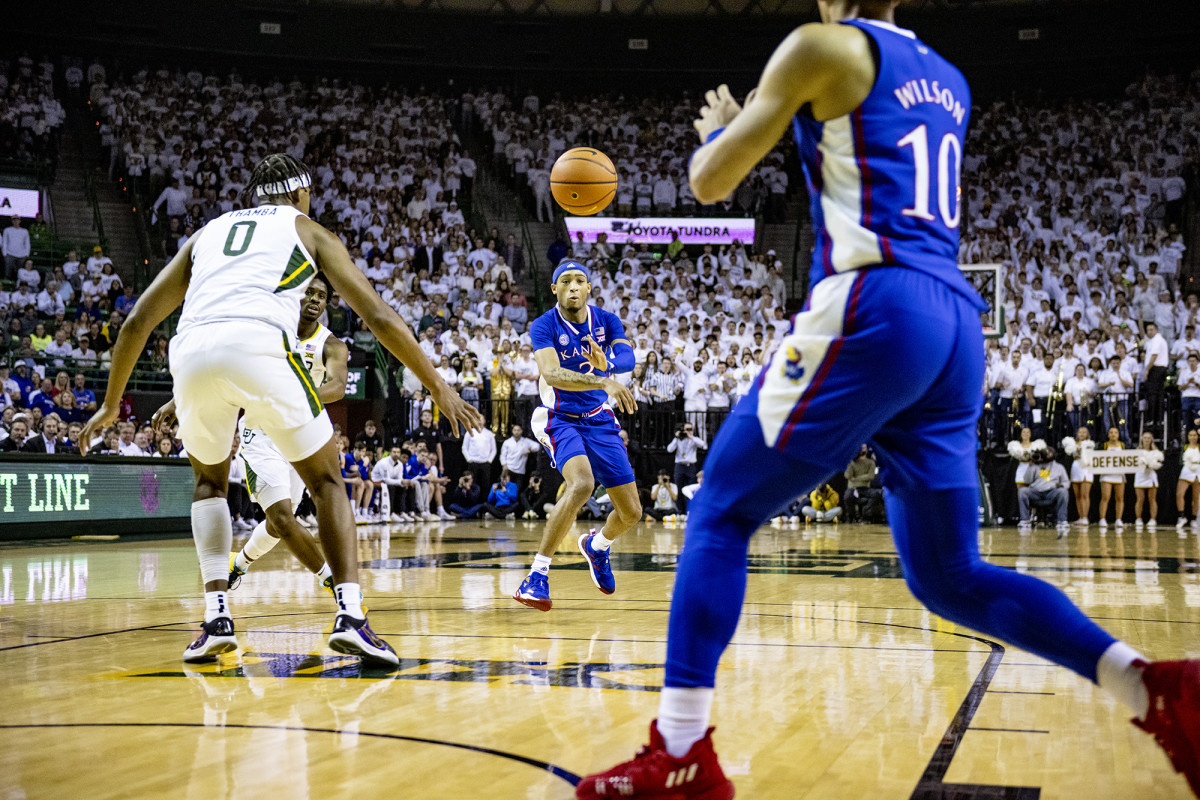The Magic Eight: One of These Teams Will Win the 2023 Men’s NCAA Tournament
Welcome back to Sports Illustrated’s Magic Eight! We’re less than a month away from Selection Sunday, and it’s time to start separating the pretenders from contenders at the top of the men’s college basketball landscape. Started by the late Grant Wahl in his days covering college hoops for SI, the Magic Eight selects the eight teams that can win that season’s national championship and weeds out those that can’t before we even see a bracket.
Last year’s Magic Eight missed the mark, leaving Kansas off because of questions at point guard and inconsistency at center. The Jayhawks answered those in March and cut down the nets in New Orleans. But it’s a new year, so hopefully I’ll have slightly better luck.

And in case you’re new to the Magic Eight, there are some rules. At least one of the eight has to come from outside the top 15 of the current AP poll, and two have to come from outside the top eight in the poll. That means some tough cuts! Here’s who made my cut and who came up just short.
All stats and rankings are as of Tuesday, Feb. 14, 2023.
Alabama (22–3, 12–0 SEC)
The Crimson Tide are without a doubt known for how fast they play and for their high-octane offense. And while it’s true that Alabama can score with virtually any team in the country, what makes this group a legitimate contender to win it all is that it also defends at an extremely high level. The Tide rank fifth in KenPom’s defensive efficiency metric, which if it stands would make them one of just six teams in the 21 seasons KenPom’s site has data for that ranked top 10 in tempo, top 20 in offensive efficiency and top 10 in defensive efficiency. That defense, built on deep drop ball screen coverage that forces opponents into a lot of long two-point shots, allows Alabama to weather the storm in games when shots don’t fall.
Alabama also isn’t as reliant on the three-point shot (which is prone to more single-game variance) as you might think a run-and-gun team like the Tide would be. Alabama ranks in the top 40 nationally in free throw rate, and the Tide are also a terrific offensive rebounding team, collecting more than 33% of their own misses. An example of the practical impacts of this: Alabama shot just 7-for-23 from three, and star freshman Brandon Miller didn’t make a field goal on the road at Houston, but the Tide still won the game thanks to 12 offensive rebounds, 32 free throw attempts and holding the Cougars to their third-worst offensive output of the season on a per-possession basis.

This team checks virtually every box: It has great size, impressive shooting, multiple ballhandlers you can trust and a nice mix of experience and top-end talent. This is a group worth betting on to at least get to Houston.
UCLA (21–4, 12–2 Pac-12)
The Bruins play a markedly different style than last year’s Kansas team that won it all, but this UCLA team reminds me a lot of the 2021–22 Jayhawks. On a possession-to-possession basis, you don’t come away enthralled when watching the Bruins: The spacing on offense isn’t ideal, there isn’t a traditional go-to scorer on the roster and they’ll rarely make the flashy play. But this group has multiple ways to beat you, is tough to kill in close games and has as much March experience as any team in the country. The Final Four run two years ago that featured holdovers like Tyger Campbell, Jaime Jaquez Jr. and Jaylen Clark is easy to remember, but the Bruins also likely would have been Final Four bound last season if not for Caleb Love’s nuclear second half in the Sweet 16.
Just as Kansas did last year, this team has an underperforming x-factor in the backcourt. Like Remy Martin last season for the Jayhawks, UCLA freshman Amari Bailey has been in and out of the lineup due to injuries and not consistently productive when on the floor. Bailey at his best provides a scoring punch the Bruins desperately need, and his emergence would be huge in getting this team over the finish line in March.
But even if Bailey doesn’t get going, this group will be a tough out. The Bruins dominate the possession battle by forcing tons of turnovers while taking good care of the basketball. Campbell isn’t Johnny Juzang, but has become a reliable shot-maker in the midrange against drop coverage. Jaquez and Clark are outstanding in the mid-post and impact the game in so many ways. It’s not always the prettiest brand of basketball, but it doesn’t need to be for this team to make a deep run.
Houston (23–2, 11–1 American)
In a season of inconsistency, the Cougars have been men’s college basketball’s most trustworthy team. Houston entered the year as the No. 3 team in the AP poll and has lived up to the hype, now sitting 23–2 and No. 1 in KenPom. This group has multiple holdovers from the Cougars’ 2021 Final Four team and last season’s Elite Eight trip, plus an elite coach in Kelvin Sampson, and veteran guards. Not to mention, this year’s men’s Final Four is in the city of Houston and will be called by Cougars alum Jim Nantz in his last Final Four. It feels like fate, right?
That said, the Cougars have their flaws. Perhaps expecting blowouts every night in conference play is unrealistic even in a weaker league like the AAC, but it does feel like Houston hasn’t played to its ceiling lately. Offensively, the lack of a true low-post scorer means the Cougars are very jump-shot reliant, which is scary in March. While Marcus Sasser and Jamal Shead make up perhaps the nation’s best backcourt because of their playmaking ability, instincts and quickness, they both are converting well under 40% of jump shots this season, and it wouldn’t take a ton for a cold shooting day to derail them in March.
Still, Houston has one of the best defenses in the country and dominates the offensive glass. That’s enough to keep your floor extremely high, and it’s been perhaps the best team in the country so far. It belongs in the conversation for the title.
Creighton (17–9, 11–4 Big East)
The Bluejays entered this season with sky-high expectations, were humbled by a six-game losing streak in November and December, but have gotten healthy and now look like the team we envisioned in the preseason.
Center Ryan Kalkbrenner is one of the most impactful players in the country. He missed three of Creighton’s six losses dealing with an illness, and his return has coincided with the Jays winning 11 of 14 games. He’s an elite rim protector defensively, but his impact on Creighton’s offense is also notable thanks to the pressure he puts on the rim as a lob threat in pick-and-roll situations. Per Hoop-Explorer, as of Tuesday the Bluejays were a remarkable 28.8 points per 100 possessions better with Kalkbrenner on the floor than off when facing top-100 opponents.

The Jays are also an unselfish team with three capable ballhandlers in Ryan Nembhard, Trey Alexander and Baylor Scheierman sharing backcourt responsibilities. Scheierman is a tough cover defensively in pick-and-pops and running off screens, while Alexander shoots north of 40% from deep and Nembhard has proven to be one of the country’s better floor generals. The one thing that could hold the Bluejays back is a lack of depth: Creighton ranks 350th nationally in bench minutes and gets very little reliable scoring from outside its starting five. But after seeing North Carolina’s “Iron Five” carry the Tar Heels to a title game appearance last year, perhaps depth is overrated in March.
Purdue (23–3, 12–3 Big Ten)
Purdue’s case is one of the more complicated ones on this list, but I believe the Boilermakers are worthy of inclusion. People are welcome to point to the Big Ten’s March struggles, Matt Painter’s lack of a Final Four or the Boilermakers’ youth in the backcourt. But outside of a disastrous four-minute stretch over the weekend that led to a shocking loss to Northwestern, this team has just been too consistently good this season for me not to believe it’ll have a seat at the table come March.
Zach Edey bucks a lot of the traditional talking points about teams built around a dominant big. Purdue has shown repeatedly that it can throw the ball to Edey in game-defining possessions in the final seconds, and Edey can either score or pass out to open shooters. Teams haven’t been able to get Edey in foul trouble, either: He has committed four fouls in a game just four times this season and has yet to foul out, despite playing more than 31 minutes per game. Teams have tried virtually every potential defensive strategy against him and none have worked. He’s simply too big and too skilled to stop.
And Purdue’s freshman guards don’t play like freshmen! The pressure-packed environment that is March Madness can cause any player to freeze up and not play their best, but Braden Smith and Fletcher Loyer have passed virtually every test so far and have played with poise well beyond their years in big moments. They’ve given us no reason not to trust them, and with Edey able to shoulder the load in must-score situations, neither guy needs to be relied on to create his own offense.
Plus, Purdue won’t beat itself. It doesn’t put its opponents at the free throw line, doesn’t turn it over, doesn’t give up offensive rebounds. Combine that with having the single most dominant player in the sport, and you’ve got the components of a championship team.
Watch college basketball with fuboTV. Start your free trial today.
Texas (20–6, 9–4 Big 12)
After dealing with the early-season tumult of Chris Beard’s arrest and subsequent firing, the Longhorns have found their stride and have been one of the nation’s best teams all season long. So while Rodney Terry may have just one NCAA tournament game as a head coach under his belt, the Longhorns as a team have too much talent and experience to not be a strong contender for a title.
Texas’s primary limitation is its shooting: The Longhorns have just two consistent three-point threats in Marcus Carr and Sir’Jabari Rice and often play with two and sometimes even three non-shooters on the floor at the same time. That’s a concerning lack of balance for a team with title aspirations. That said, Texas does run a highly efficient offense despite its lack of three-point firepower, thanks to a group that is relentless attacking the rim and is excellent at taking care of the basketball. Plus, when Texas does make threes, its offense is nearly impossible to stop, scoring 90-plus points in all but one game in which it has made 10 or more threes.
The Longhorns’ ballhandling depth is a major strength, and both Carr and Tyrese Hunter are experienced veterans you can trust in big spots. Texas also gets to the line plenty and makes its free throws, shooting over 80% from the stripe in Big 12 play. This is also an incredibly old team: Its rotation features three graduate students, three seniors and a sophomore that played in the Sweet 16 last season.
At the end of the day, this group is battle-tested. It has been the best team in a historically good Big 12 this season. If you can win that league, you can win a national championship, and the Longhorns are well-positioned to do just that.
Kansas (21–5, 9–4 Big 12)
Leaving out Kansas was one of the hardest decisions I made in finalizing my Magic Eight last year, and the Jayhawks made me regret that decision by winning it all. So no matter how hard it is to repeat as champs, I refuse to make the same mistake twice and bet against a Bill Self team.
The strengths of this KU team are its versatility and unselfishness. The Jayhawks rank in the top 20 nationally in assist rate and are a joy to watch share the basketball, with a pure pass-first point guard Dajuan Harris Jr. leading the charge and skilled big man KJ Adams Jr. providing some unique looks as a distributor in short roll situations. With its starting five on the floor Kansas can push the pace with all five players capable of putting the ball on the deck, and defensively can switch on almost all screens thanks to the length of wings Gradey Dick, Kevin McCullar Jr. and Jalen Wilson. Plus, the team’s role allocation is outstanding: Wilson is the primary scorer, Dick the sharpshooter, McCullar the defense-first wing who can make corner threes, Adams the dirty work guy and Harris the distributor.

Harris is the engine for Kansas, and when he struggles offensively, the Jayhawks look a lot more beatable. He has scored nine total points in the team’s five losses this season but averages more than 9.0 ppg in the team’s wins. With a very thin bench, Kansas needs the occasional bucket from Harris to keep the defense honest, particularly given how much some opponents will play off him from beyond the arc. If he plays as well as he did last March, Self’s program has a very real chance of cutting down the nets again.
Baylor (20–6, 9–4 Big 12)
History is not on Baylor’s side when it comes to winning a championship with a defense that rates as poorly as the Bears’ does. Baylor currently ranks as the No. 79 defense in the country per KenPom, and no team ranked outside the top 50 has ever won it all.
That said, I think there’s reason to believe the Bears’ defense will look a lot different by mid-March. Baylor has played most of the season without big man Jonathan Tchamwa Tchatchoua, who only recently returned from a devastating knee injury suffered late last season. Tchamwa Tchatchoua is one of the toughest players in the country, an emotional leader for this Baylor team and, most importantly, the quarterback of its no-middle defense when on the floor. The Bears’ D wasn’t the same last year after Tchamwa Tchatchoua went down, contributing to their early tournament exit against North Carolina. Since returning earlier this month, Tchamwa Tchatchoua looks healthy and has steadily increased his minutes load. This could be a much better defensive team in a month.
And if Baylor starts defending at a higher level, watch out. No team has a more dynamic backcourt than Scott Drew’s club, with three prolific shotmakers in Keyonte George, LJ Cryer and Adam Flagler, each of whom has scored 20 or more points at least five times this season. Combine three explosive guards with an offense that also is elite at getting on the offensive glass and getting to the free throw line, and the Bears are more than capable of winning a shootout or two in March.
Since an 0–3 start in Big 12 play, Baylor has won 10 of 11 games. The 2020–21 champs are starting to look like a title team again, and if Tchamwa Tchatchoua can help fix the defense, Baylor has a great chance to make it to Houston and win it all.
Notable Omissions:
Virginia (19–4, 11–3 ACC)
The Cavaliers are the highest-ranked team to miss the Magic Eight cut and do check a lot of the traditional boxes you look for in a title team. They’re experienced, have a championship-winning coach in Tony Bennett and some impressive wins this season against the likes of Baylor and Illinois. I just question whether this team has the top-end talent necessary to win it all. Virginia’s 2018–19 title team had a future lottery pick in De’Andre Hunter, a first-round pick in Ty Jerome and a second rounder in Kyle Guy. This team’s core has just one future NBA player in defensive wizard Reece Beekman.
Arizona (22–4, 11–4 Pac-12)
There’s a lot to like here with Arizona: It won the Maui Invitational against top competition and has experience from last year’s Sweet 16 run and a National Player of the Year contender in Azuolas Tubelis. But do the Wildcats have good enough guards to win a championship? Point guard Kerr Kriisa may be entertaining to watch, but he still may be too volatile to build a title team around. Backcourt running mate Courtney Ramey has also been up-and-down, and the Wildcats playing two bigs could hurt them defensively in March without a switchable center like Christian Koloko was last season.

Tennessee (19–6, 8–4 SEC)
Even before the Vols lost three of their last four, there were reasons to doubt them in a single-elimination setting. Tennessee’s offense has been inconsistent and heavily relies upon jump-shooting, which makes it vulnerable when the shots aren’t falling. Consider last year’s surprise round-of-32 exit against Michigan, when the Vols went just 2-for-18 from three after shooting better than 40% from deep in five consecutive games leading up to it. Plus, Rick Barnes’s shaky March track record is tough to ignore.
UConn (19–7, 8–7 Big East)
The Huskies are the highest ranked in KenPom of our omissions, and there’s no doubt this team has at points looked like a championship-level one. UConn was clearly the best team in the country in November and December, but extended shooting struggles and inconsistent point guard play have the Huskies just 8–7 in league play. Double-figure wins over Alabama, Iowa State and Marquette prove this team can beat anyone in the country, but winning six straight in March is hard to bet on with how it’s played lately.
Gonzaga (21–5, 10–2 WCC)
The Bulldogs have been perennial contenders in the last five years without getting over the hump. This year’s team is far more flawed than the squads that have come up short lately, with significant deficiencies defensively and less dynamic guards than the Zags have had in the past. It would be peak March Madness for this Gonzaga team to be the one that finally cuts down the nets, but I have a hard time seeing it.
Indiana (18–7, 9–5 Big Ten)
The Hoosiers are rounding into form at the right time, beating Purdue and getting a key road win at Michigan in the last two weeks. They’re also getting healthier, with Race Thompson back at power forward and point guard Xavier Johnson getting closer to a return. Indiana has a future NBA guard in Jalen Hood-Schifino, an All-American up front in Trayce Jackson-Davis and plenty of experience. I couldn’t quite justify putting it in the Magic Eight today, but I may regret that come Selection Sunday.
North Carolina (16–10, 8–7 ACC)
North Carolina has been nowhere near as good this season as the other teams on this list, but it does bear a mention because of last year’s run to the national championship game. The Heels are in some ways built for March Madness, with volatile but dynamic guards who can create their own offense, a dominant big on the inside in Armando Bacot and plenty of experience in the Big Dance. So while the Tar Heels may be sweating out the bubble on Selection Sunday, no team will want to see them in their region. Still, to make another deep run, UNC needs improved shooting from RJ Davis and Caleb Love and to get consistency at the power forward position.
